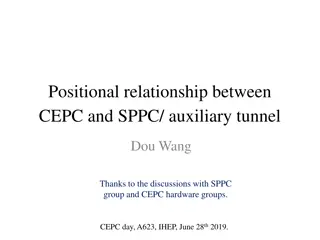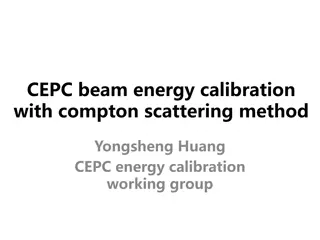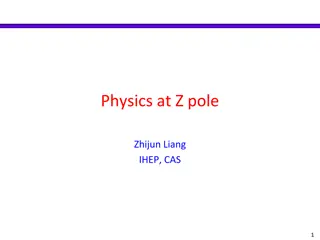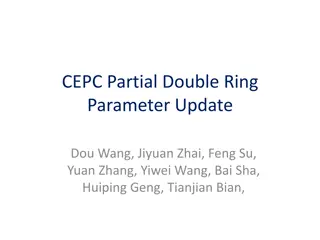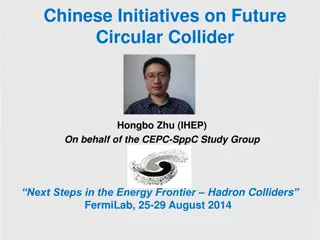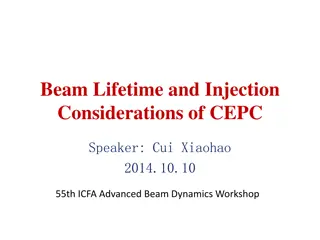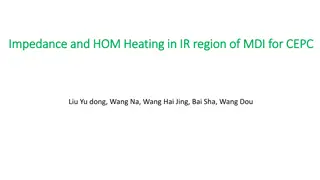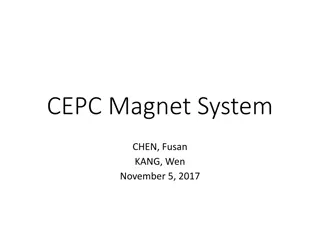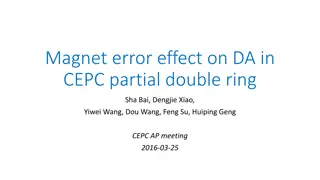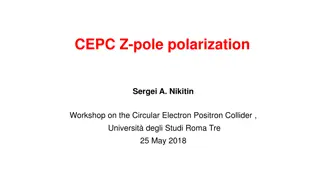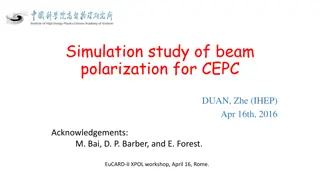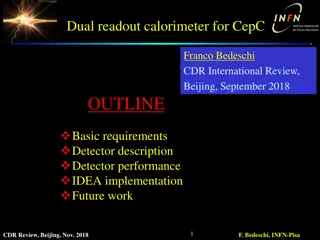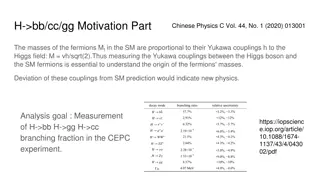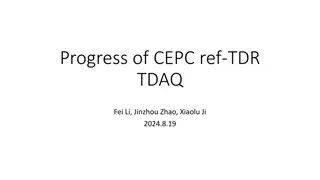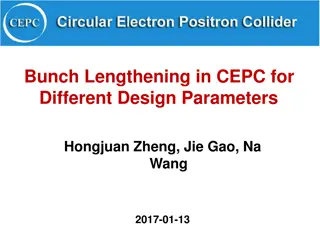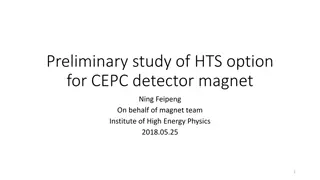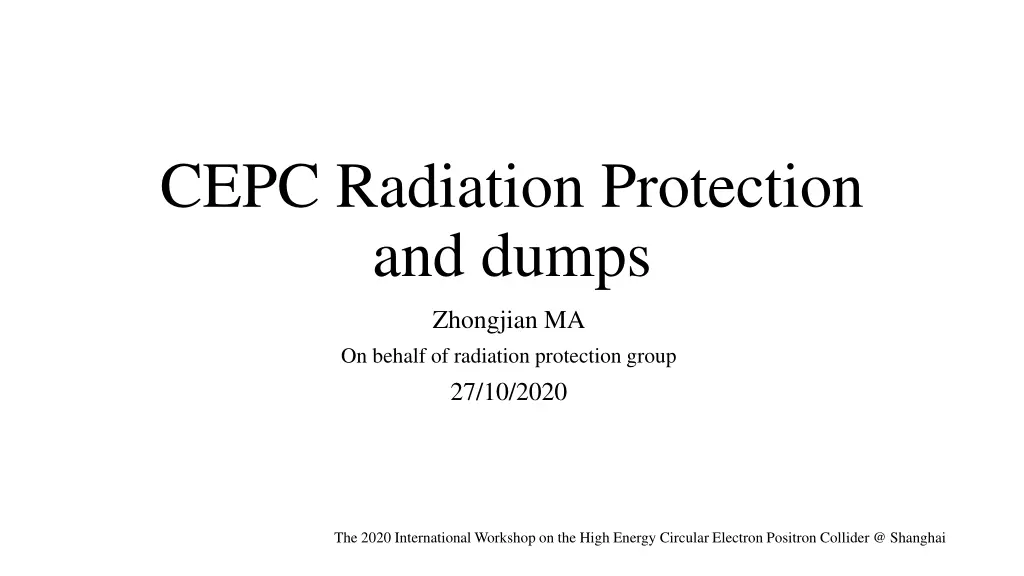
Radiation Protection Design and Shielding Criteria in High-Energy Collider Workshop
Explore radiation protection and shielding criteria discussed at the 2020 International Workshop on the High-Energy Circular Electron-Positron Collider in Shanghai. Learn about design considerations, radiological impact, and shielding design criteria for ensuring safety in the collider facility.
Download Presentation

Please find below an Image/Link to download the presentation.
The content on the website is provided AS IS for your information and personal use only. It may not be sold, licensed, or shared on other websites without obtaining consent from the author. If you encounter any issues during the download, it is possible that the publisher has removed the file from their server.
You are allowed to download the files provided on this website for personal or commercial use, subject to the condition that they are used lawfully. All files are the property of their respective owners.
The content on the website is provided AS IS for your information and personal use only. It may not be sold, licensed, or shared on other websites without obtaining consent from the author.
E N D
Presentation Transcript
CEPC Radiation Protection and dumps Zhongjian MA On behalf of radiation protection group 27/10/2020 The 2020 International Workshop on the High Energy Circular Electron Positron Collider @ Shanghai
Content Radiation protection design introduction Dump design for main ring Dump design for Linac Radioactive characteristics analysis for main ring Summary
Radiological impact considerations Radiation protection design procedure Dose monitoring and access control Dose optimization Operation mode Source term Shielding design Main shielding consideration aspects Impact factors Impact factors Characteristics Characteristics Radiation damage to magnet coil Over heat load to ventilation system Formation of ozone and nitrogen oxides in the air Slightly activation to the material around Synchrotron radiation Synchrotron radiation Cause secondary radiation inside the tunnel Determine the bulk shielding thickness Random beam loss Random beam loss Hot spots Hot spots Collimation locations, dump and transfer line and heat analysis, injection/extraction point, Linac dumps Dose from stray radiation emitted during machine running Radionuclides in the cooling water, underground water, tunnel air, soil Radioactivity analysis for the solid components and waste Radiological impact to Radiological impact to environment environment
Shielding Design Criteria Basic Rules of Radiation Protection Justification, Limitation, Optimization Annual dose limit adopted by different owners radiation workers Owners Public B <6mSv <6mSv A <20mSv <20mSv Eu-Directive France Switzerland CERN from 2004 CERN until 2004 China IHEP <1mSv <1mSv <1mSv <0.3mSv <0.3mSv <1mSv <0.1mSv <20mSv <6mSv <20mSv <20mSv <20mSv <5mSv
Radiation dose monitor system(RDMS) Goal: guarantee the radiation level of workplace and the environment around complies with relevant regulations. State of the art system: once radiation level exceeds the set critical value, monitors would sound the alarm. Main includes: Data acquisition program Workplace monitoring program Environmental monitoring program Personal dose monitoring program Management of radioactive components
RDMS & PPS & EHS RDMS RDMS provides remote supervision, long term provides remote supervision, long term database storage and off database storage and off- -line data analysis PPS PPS (Personal Protection System) Includes PLC system, (Personal Protection System) Includes PLC system, access control system, database server access control system, database server line data analysis System framework System framework Date communication methods Date communication methods Schematic diagram of the PPS Schematic diagram of the PPS A pre-research project was established to solve the problem of saturation for neutron measurement at high instantaneous dose rate. More radiation field detection methods was also investigated and co-researched for future radiation detection PPS system was now mainly designed by Accelerator Control staff More detailed information about RDMS, PPS and EHS(Environment, Health and Safety considerations) can refer CDR Chapter 7.3 and Chapter 10.
Main ring dump-lattice design By Xiaohao CUI Based on Z-2T model, a set of kicker magnets has been used to dilute the beam horizontally and vertically Bunch distribution on the dump surface is assumed to be 25cm x 25cm; The highest temperature rise on the dump core is reasonable from thermal conduction formula calculation The length of transfer tunnel is about 100m; the diameter is about 2m, considering the vacuum equipment, pipe installation The size for dump cavern is about 5m in transverse and 7m in longitudinal Dilution kicker requirement: Dilution kicker requirement: 1. Horizontal kicker should periodic oscillate 50 times in 300 us 2. Vertical kicker should reduce from max value to minimum in 300 us 7
Main ring dump-lattice design By Xiaohao CUI Beam parameters for different operation models number of particles per bunch 10^10 24.15 17 12 8 15 beam loss power W/m Time/s Dump in one cycle beam current cal mA energy stored in the tunnel/ MJ Prompt Power on the target / MW Operation Model bunch number beam current mALifetime h Beam loss electrons/s Energy GeV tt 175 120 80 45.5 45.5 34 218 1568 12000 15000 3.95 17.8 90.4 461 1081.4 0.7 0.22 1.2 2 1.8 3.26E+09 4.68E+10 4.36E+10 1.33E+11 3.47E+11 9.12E-04 8.98E-03 5.58E-03 9.71E-03 2.53E-02 3.33E-04 3.33E-04 3.33E-04 3.33E-04 3.33E-04 3.94 17.79 90.32 460.80 1080.00 0.23 0.71 2.41 6.99 16.38 6.90E+02 2.13E+03 7.23E+03 2.10E+04 4.91E+04 Higgs W Z-2T Z-3T Keep the drift distance is 100m, two sets of dilution kicker requirements were designed Set 1: keep the magnet strength is the same Set 2: maximum the bunch distribution on the dump surface, about 30cm*30cm 8
Bunch distribution and analysis The bunch distributions for 5 operation models on the dump surface is simulated by physics group and detailed analyzed. Focus on 4 sub regions because the bunches in these regions are smaller than any others. Modified Fluka recording card to enlarge the limit on number of bins; Bin size is about mm@z direction and ten um@xy direction Find the bin which contain maximum energy deposition Through thermal conduction formula to calculate the temperature rise Energy deposition on the dump core Bunch distribution-tt model 9 Sig_x & Sig_y analysis for tt operation bunch distribution
Bunch distribution and analysis-con Higgs mode W threshold Z-2T Z-3T Z 3T Z 2T high-lumi
Energy deposition and temperature rise-pre Z(2T high lumi) ttbar Higgs WW Z(3T) Beam 175 120 80 45.5 energy/GeV Ne/bunch/1010 24 17 12 8.0 15 Bunch number 34 218 1569 12000 15000 Total energy/MJ 0.2 0.7 2.4 7.0 16.4 Maximum temperature rise 229 3 138 4 102 2 736 56 --- Table: The highest temperature rise in the setting bins Figure: Energy deposition map for Higgs model, from Fluka simulation 11
Radiation dose level inside Linac Linac parameters from CDR Radiation dose level inside the Linac tunnel is important for it determine the local shielding thickness for hot points inside Linac. Beam was lost alone the beamline linearly. Roughly assumption: 10GeV electron, about 10% population is lost alone the beamline. The beam loss scenario will be divided into several sections, for beam will loss mainly in the low energy section. Geometry construction in the FLAIR
Radiation hot points inside Linac Radiation hot points like beam energy analysis stations, collimator stations, positron target station, dumps should be local shielded in order to minimize the shielding thickness. Two kinds of prompt radiation inside Linac tunnel: radiation from hot points and from linearly beam loss Most hot points inside Linac is used for beam energy analysis in different location. Bunch populartion/ ???? Bunch size/mm Freque ncy/Hz No. Purpose of dumps Beam energy Charge/nC 1 Beam Energy Analysis 60MeV 2/1 1 10 6.3 2 Beam Energy Analysis 1.2GeV 0.5/0.5 1 10 6.3 3 Beam Energy Analysis 250MeV 1.5/1.5 1 5 3.2 4 Positron target position 4GeV - - - 6.0 5 Dump for Linac beam 10GeV 0.5/0.5 1 3 1.9
Local shield design for hot points Carbon and iron was selected as the absorber material, surrounded by the concrete as local shielding. 5.5mSv/h dose rate was set as an preliminary dose rate limit to decide the local shielding thickness. Beam Beam energy energy Trans. Area Trans. Area /m^2 /m^2 Length/m Length/m 60MeV 0.75*0.75 1.36 1.2GeV 1.56*1.56 3.05 250MeV 0.98*0.98 1.56 11GeV 2.10*2.10 3.36 Preliminary design results for different beam energy analysis station: Radiation level nearby each energy analysis station was figured out, also specify a roughly space for the future local shielding. Local size selection (10GeV dump as example): 2D map of dose distribution was simulated by FLUKA, the dose rate alone Z or X axis was averaged by 10*10cm^2 area, the shielding size can be selected by the setting dose rate limit. Absorber geometry and local shielding: Size for carbon and iron for different beam energy, adopt from other projects, is suitable but haven't been optimized.
Radiation dose level inside the main ring A geometry with a set of detailed dipole, quadruple and sextuple was constructed for SR shielding simulation, based on this: A layer of concrete shell added to simulate the scattering effect. Radioactivity in the tunnel air, ground water, soil, cooling water was simulated. Beam loss assumption: total number of electron inside the beam pipe is lost linearly in the whole ring, the time interval is the beam life time. Beam loss parameter: 8.5E6 e/s Annual running time: 10 months Ground water Tunnel air around beampipe Soil Cooling water
Radioactive characteristics for main ring Residual nuclei and activity was simulated, the residual nuclei production was analyzed and compared with the exempted activity concentration. Concentration limit of induced activity According to GB18871-2002: if there are more than one kind of radionuclide, only if the ratio of activity (or specific activity) to its exempt value of each kind of the radionuclide was less than 1, it is exemptible. ? ??_ < 1 ??_?????? ?=1 Convenient method to soil and ground water activation: The prompt dose rate is ~5.5mSv/h in the thickness of 1m soil to ensure it is below the exempt value of above. (refer J-PARC)
Residual nuclei The most important radionuclides in the tunnel air: O-15, N-13, C-11,Ar-41,H-3, Be-7 Cooling water Mass number e number 3 H 1 6 He 2 7 Be 4 8 Li 3 8 Be 4 8 B 5 9 Li 3 10 C 6 11 Be 4 11 C 6 12 B 5 12 N 7 13 B 5 13 N 7 14 O 8 15 O 8 16 N 7 Air in tunnel Mass number e number 3 H 1 6 He 2 7 Be 4 8 Li 3 8 Be 4 8 B 5 9 B 5 9 C 6 10 C 6 11 Be 4 11 C 6 12 B 5 13 N 7 14 C 6 15 O 8 28 Al 13 31 Si 14 33 P 15 37 Ar 18 38 Cl 17 39 Cl 17 41 Ar 18 nam Atomic Exempt specific activity /(Bq/g) 1.00E+06 Specific activity/exempt specific activity 2.16883E-09 nam Atomic Exempt specific activity /(Bq/g) 1.00E+06 Specific activity/exempt specific activity 3.39617E-08 Bq Bq 1.95E+02 1.57E+02 1.39E+03 1.57E+02 2.36E+02 3.94E+01 3.94E+01 3.94E+01 1.18E+02 3.94E+01 2.36E+03 7.87E+01 2.60E+03 1.66E+01 2.95E+03 3.94E+01 3.94E+01 3.93E+01 3.93E+01 3.94E+01 3.94E+01 3.54E+02 summation 4.69E+02 3.15E+02 3.78E+03 5.51E+02 1.02E+03 4.33E+02 7.87E+01 4.33E+02 7.87E+01 9.41E+03 4.72E+02 7.87E+01 7.87E+01 1.61E+03 9.05E+02 3.63E+04 2.76E+02 summation 1.00E+03 1.54916E-05 1.00E+03 0.000274172 1.00E+04 1.00E+02 1.85342E-08 0.000328891 1.00E+02 0.026322846 1.00E+03 1.00E+05 1.00E+06 4.38558E-07 4.38447E-09 4.37555E-10 0.026597052 The most important radionuclides in the cooling water: O-15, C-11, Be-7 1.00E+02 3.94758E-05 0.000384322
Soil out of tunnel Mass number e number 6He 2 7Be 4 8Be 4 11C 6 13N 7 15O 8 16N 7 18F 9 22Na 11 23Mg 12 24Na 11 25Al 13 27Mg 12 27Si 14 28Al 13 29Al 13 31Si 14 37Ar 18 38K 19 42K 19 45Ca 20 51Cr 24 53Fe 26 54Mn 25 55Fe 26 56Mn 25 59Fe 26 Residual nuclei nam Atomic Exempt specific activity /(Bq/g) Specific activity/exempt specific activity Bq 5.51E+02 2.28E+03 6.68E+02 4.01E+03 7.48E+02 1.49E+04 1.85E+03 6.69E+02 6.35E+02 5.51E+02 3.12E+04 5.90E+02 2.64E+03 1.23E+04 2.08E+05 1.30E+03 1.91E+04 3.97E+03 8.46E+02 1.53E+04 2.11E+03 1.14E+03 6.69E+02 2.44E+03 1.74E+04 1.58E+05 1.56E+03 1.00E+03 1.92835E-07 Underground water out of tunnel Mass number e number activity /(Bq/g) 3 H 1 3.91E+02 1.00E+06 6 He 2 4.72E+02 7 Be 4 2.16E+03 1.00E+03 8 Li 3 6.30E+02 8 Be 4 7.47E+02 8 B 5 7.87E+01 9 Li 3 7.87E+01 10 C 6 1.97E+02 11 C 6 7.75E+03 12 B 5 5.51E+02 12 N 7 7.87E+01 13 N 7 1.14E+03 14 O 8 5.51E+02 15 O 8 3.10E+04 100 16 N 7 2.76E+03 summation 1.00E+02 1.26016E-05 nam Atomic Exempt specific Specific activity/exempt specific activity 5.29946E-11 10 10 5.66565E-06 5.37771E-06 Bq 2.92954E-07 1.00E+03 1.00E+06 1.62009E-06 3.35789E-10 1.00E+02 1.00E+04 1.00E+03 1.29319E-05 1.78608E-08 9.66294E-08 4.2019E-05 10 2.06301E-05 1.47104E-07 0.001341463 1.32114E-05 4.2312E-05 1.00E+04 1.00E+01 1.00E+01 24Na 26Al 38K 11 13 19 1.56E+04 1.12E+04 8.07E+02 summation 1.00E+01 0.000131775 0.001545732
Radiation dose level inside the main ring In the arc section of main ring, the most important two radiation sources are from synchrotron In the arc section of main ring, the most important two radiation sources are from synchrotron radiation and random beam loss. radiation and random beam loss. Radiation caused by synchrotron is more serious Secondary radiation components from random beam loss is harder and more liable to produce radioactivity in the material surrounded. Prompt radiation dose caused by synchrotron radiation Prompt radiation dose caused by random beam loss
Summary Radiation dose monitoring system and personnel protection system have been designed. Radiation level inside Linca and main ring was simulated, a preliminary local shielding scheme for hot points was proposed. Maximum energy deposition and temperature rise on the dump absorber was analyzed; Radiological characteristics of different components was simulated. Radiation shielding design is being detailed and refined as the project proceed.
End! Thanks for your attention!




